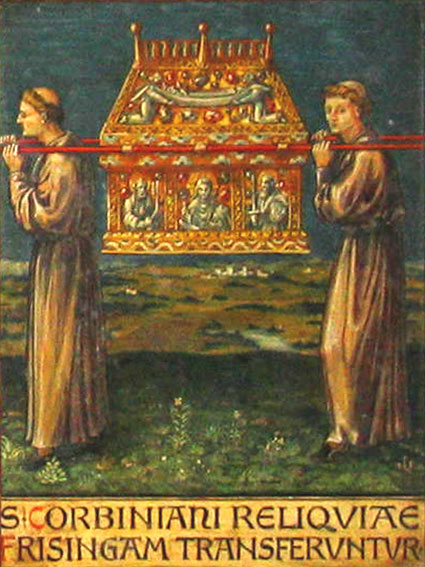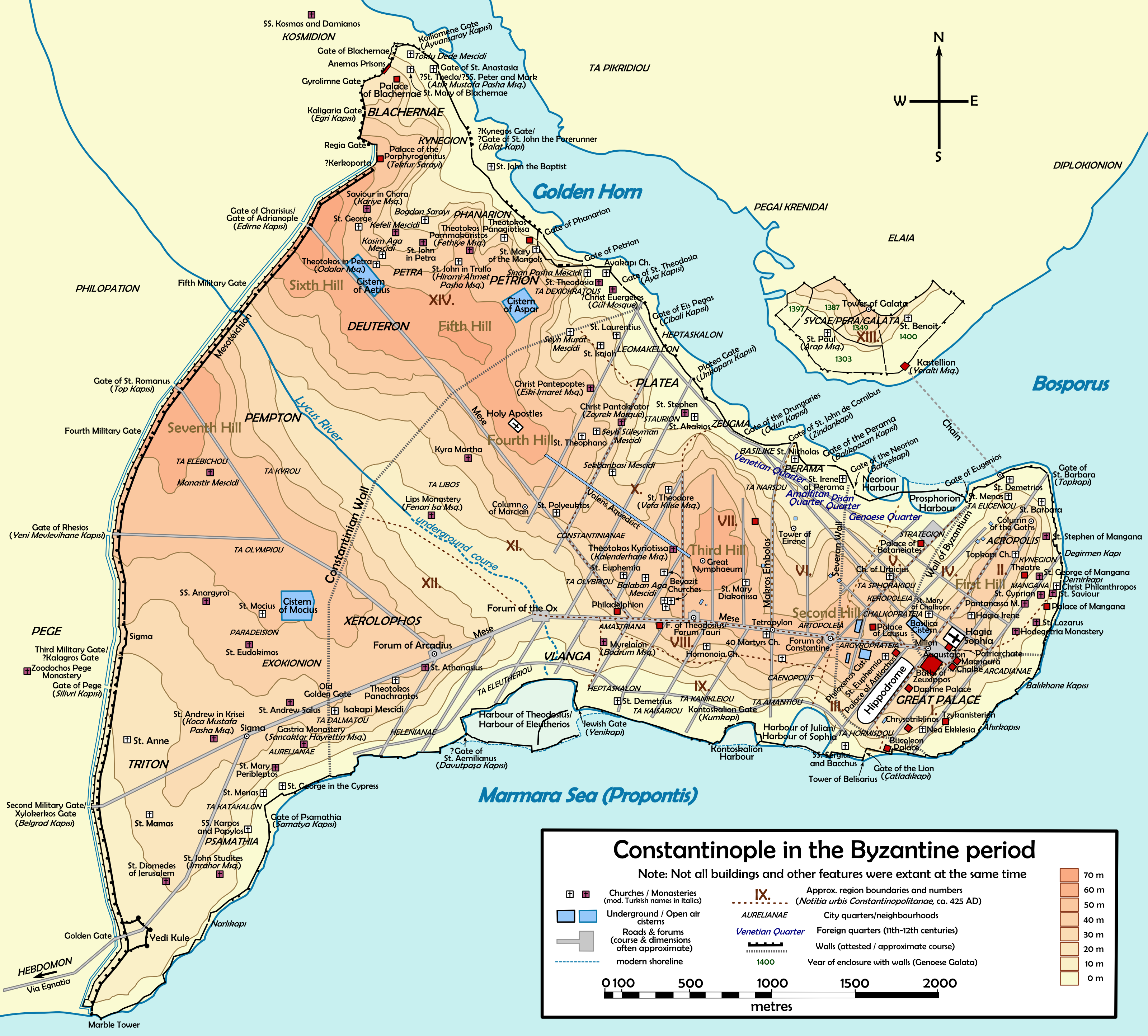|
Mandylion Of Edessa
According to Christian tradition, the Image of Edessa was a holy relic consisting of a square or rectangle of cloth upon which a miraculous image of the face of Jesus Christ had been imprinted—the first icon (). The image is also known as the Mandylion (, 'cloth' or 'towel'), in Eastern Orthodoxy, it is also known as Acheiropoieton (, ). In the tradition recorded in the early 4th century by Eusebius of Caesarea, King Abgar of Edessa wrote to Jesus, asking him to come cure him of an illness. Abgar received a reply letter from Jesus, declining the invitation, but promising a future visit by one of his disciples. One of the seventy disciples, Thaddeus of Edessa, is said to have come to Edessa, bearing the words of Jesus, by the virtues of which the king was miraculously healed. Eusebius said that he had transcribed and translated the actual letter in the Syriac chancery documents of the king of Edessa, but who makes no mention of an image. The report of an image, which accrue ... [...More Info...] [...Related Items...] OR: [Wikipedia] [Google] [Baidu] |
Evagrius Scholasticus
Evagrius Scholasticus () was a Syrian scholar and intellectual living in the 6th century AD, and an aide to the patriarch Gregory of Antioch. His surviving work, ''Ecclesiastical History'' (), comprises a six-volume collection concerning the Church's history from the First Council of Ephesus (431) to the emperor Maurice’s reign until Scholasticus' death. Life Evagrius Scholasticus was born in Epiphania, a Syrian town located next to the Orontes River in the heart of the Eastern Roman Empire. Glenn Chesnut gives his date of birth as either 536 or 537; Michael Whitby says "about 535". His first written work addressed the plague outbreak which infected a vast segment of the population. Evagrius himself was infected by the outbreak during his youth yet managed to survive it. According to his own account, close members of his family died from the outbreak, including his wife at the time. Michael Whitby reasons that Evagrius was born into a wealthy aristocratic family with close ... [...More Info...] [...Related Items...] OR: [Wikipedia] [Google] [Baidu] |
Abgar Of Edessa
Abgar V (c. 1st century BC – c. AD 50), called Ukkāmā (meaning "the Black" in Syriac and other dialects of Aramaic), was the King of Osroene with his capital at Edessa. Background Abgar was described as "king of the Arabs" by the Roman historian Tacitus, a near-contemporary source. The 5th-century Armenian historian Moses of Chorene depicted Abgar as an Armenian, but modern scholarly consensus agree that the Abgarids were in fact an Arab dynasty. Moses of Chorene notes that Abgar V's chief wife was Queen Helena of Adiabene, but according to the contemporary Jewish historian Josephus she was the wife of King Monobaz I of Adiabene. Letter of Abgar to Jesus Abgar V is said to be one of the first Christian kings, having been converted to the faith by Thaddeus of Edessa, one of the seventy disciples. The church historian Eusebius recorded that the Edessan archives contained a copy of a correspondence exchanged between Abgar of Edessa and Jesus. The correspondence cons ... [...More Info...] [...Related Items...] OR: [Wikipedia] [Google] [Baidu] |
Translation (relic)
In Christianity, the translation of relics is the ceremonial removal of holy objects from one place to another (usually a higher-status location). Usually only the movement of the remains of a saint's body would be treated so formally, with secondary relics such as items of clothing treated with less ceremony. Translations could be accompanied by many acts, including all-night vigils and processions, often involving entire communities. The solemn translation (in Latin, ) of relics is not treated as the outward recognition of sanctity. Rather, miracles confirmed a saint's sanctity, as evinced by the fact that when the papacy attempted to make canonization an official process in the twelfth century, many collections of miracles were written in the hope of providing proof of the saint-in-question's status. In the early Middle Ages, the solemn translation marked the moment at which, the saint's miracles having been recognized, the relic was moved by a bishop or abbot to a prominent po ... [...More Info...] [...Related Items...] OR: [Wikipedia] [Google] [Baidu] |
Robert Eisenman
Robert Eisenman (born 1937) is an American biblical scholar, historian, archaeologist, and poet. He is currently professor of Middle East religions, archaeology, and Islamic law and director of the Institute for the Study of Judaeo-Christian Origins at California State University Long Beach. Eisenman led the campaign to free up access to the Dead Sea Scrolls in the 1980s and 90s, and, as a result of this campaign, is associated with the theory that combines Essenes with Palestinian messianism (or what some might refer to as "Palestinian Christianity") – a theory opposed to establishment or consensus scholarship. Before this, Eisenman spent five years "on the road" in the United States, Europe, and the Middle East as far as India, encapsulating all these things in his poetic travel ''Diario'' (1959–62), published in 2007 by North Atlantic Books, Berkeley, California and called ''The New Jerusalem'', in which he describes the San Francisco " Beat" scene in 1958–59, Paris wh ... [...More Info...] [...Related Items...] OR: [Wikipedia] [Google] [Baidu] |
Provenance
Provenance () is the chronology of the ownership, custody or location of a historical object. The term was originally mostly used in relation to works of art, but is now used in similar senses in a wide range of fields, including archaeology, paleontology, archival science, circular economy, economy, computing, and Scientific method, scientific inquiry in general. The primary purpose of tracing the provenance of an object or entity is normally to provide contextual and circumstantial evidence for its original production or discovery, by establishing, as far as practicable, its later history, especially the sequences of its formal ownership, custody and places of storage. The practice has a particular value in helping Authentication, authenticate objects. Comparative techniques, expert opinions and the results of scientific tests may also be used to these ends, but establishing provenance is essentially a matter of documentation. The term dates to the 1780s in English. Provenance ... [...More Info...] [...Related Items...] OR: [Wikipedia] [Google] [Baidu] |
Paris
Paris () is the Capital city, capital and List of communes in France with over 20,000 inhabitants, largest city of France. With an estimated population of 2,048,472 residents in January 2025 in an area of more than , Paris is the List of cities in the European Union by population within city limits, fourth-most populous city in the European Union and the List of cities proper by population density, 30th most densely populated city in the world in 2022. Since the 17th century, Paris has been one of the world's major centres of finance, diplomacy, commerce, culture, Fashion capital, fashion, and gastronomy. Because of its leading role in the French art, arts and Science and technology in France, sciences and its early adoption of extensive street lighting, Paris became known as the City of Light in the 19th century. The City of Paris is the centre of the Île-de-France region, or Paris Region, with an official estimated population of 12,271,794 inhabitants in January 2023, or ... [...More Info...] [...Related Items...] OR: [Wikipedia] [Google] [Baidu] |
Sainte-Chapelle
The Sainte-Chapelle (; ) is a royal chapel in the Gothic style, within the medieval Palais de la Cité, the residence of the Kings of France until the 14th century, on the Île de la Cité in the River Seine in Paris, France. Construction began sometime after 1238 and the chapel was consecrated on 26 April 1248. The Sainte-Chapelle is considered among the highest achievements of the Rayonnant period of Gothic architecture. It was commissioned by King Louis IX of France to house his collection of Passion relics, including Christ's claimed Crown of Thorns – one of the most important relics in medieval Christendom. This was later held in the nearby Notre-Dame Cathedral until the 2019 fire, which it survived. Along with the Conciergerie, Sainte-Chapelle is one of the earliest surviving buildings of the Capetian royal palace on the Île de la Cité. Although damaged during the French Revolution and restored in the 19th century, it has one of the most extensive 13th- ... [...More Info...] [...Related Items...] OR: [Wikipedia] [Google] [Baidu] |
Louis IX Of France
Louis IX (25 April 1214 – 25 August 1270), also known as Saint Louis, was King of France from 1226 until his death in 1270. He is widely recognized as the most distinguished of the Direct Capetians. Following the death of his father, Louis VIII, he was Coronation of the French monarch, crowned in Reims at the age of 12. His mother, Blanche of Castile, effectively ruled the kingdom as regent until he came of age, and continued to serve as his trusted adviser until her death. During his formative years, Blanche successfully confronted rebellious vassals and championed the Capetian cause in the Albigensian Crusade, which had been ongoing for the past two decades. As an adult, Louis IX grappled with persistent conflicts involving some of the most influential nobles in his kingdom, including Hugh X of Lusignan and Peter I of Brittany. Concurrently, England's Henry III of England, Henry III sought to reclaim the Angevin Empire, Angevin continental holdings, only to be decisively def ... [...More Info...] [...Related Items...] OR: [Wikipedia] [Google] [Baidu] |
Fourth Crusade
The Fourth Crusade (1202–1204) was a Latin Christian armed expedition called by Pope Innocent III. The stated intent of the expedition was to recapture the Muslim-controlled city of Jerusalem, by first defeating the powerful Egyptian Ayyubid Sultanate. However, a sequence of economic and political events culminated in the Crusader army's 1202 siege of Zara and the 1204 sack of Constantinople, rather than the conquest of Egypt as originally planned. This led to the Partitio terrarum imperii Romaniae or the partition of the Byzantine Empire by the Crusaders and their Venetian allies leading to a period known as Frankokratia, or "Rule of the Franks" in Greek. In 1201, the Republic of Venice contracted with the Crusader leaders to build a dedicated fleet to transport their invasion force. However, the leaders greatly overestimated the number of soldiers who would embark from Venice, since many sailed from other ports, and the army that appeared could not pay the contracted price. I ... [...More Info...] [...Related Items...] OR: [Wikipedia] [Google] [Baidu] |
Sack Of Constantinople
The sack of Constantinople occurred in April 1204 and marked the culmination of the Fourth Crusade. Crusaders sacked and destroyed most of Constantinople, the capital of the Byzantine Empire. After the capture of the city, the Latin Empire (known to the Byzantines as the '' Frankokratia'', or the Latin occupation) was established and Baldwin of Flanders crowned as Emperor Baldwin I of Constantinople in Hagia Sophia. After the city's sacking, most of the Byzantine Empire's territories were divided up among the Crusaders. Byzantine aristocrats also established a number of small independent splinter states—one of them being the Empire of Nicaea, which would eventually recapture Constantinople in 1261 and proclaim the reinstatement of the Empire. However, the restored Empire never managed to reclaim all its former territory or attain its earlier economic strength, and it gradually succumbed to the rising Ottoman Empire over the following two centuries. The Byzantine Empire ... [...More Info...] [...Related Items...] OR: [Wikipedia] [Google] [Baidu] |







